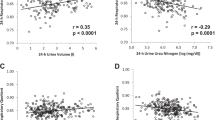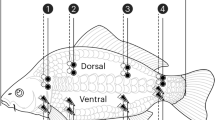Abstract
BACKGROUND/OBJECTIVES:
Hydration state can be assessed via body mass change (BMΔ), serum and urine osmolality (Sosm, Uosm), urine-specific gravity (Usg) and urine volume (Uvol). As no hydration index has been shown to be valid in all circumstances, value exists in exploring novel biomarkers such as salivary osmolality (Vosm). Utilizing acute BMΔ as the reference standard, this research examined the efficacy of Sosm, Vosm, Uosm, Uvol and Usg, during passive (PAS) and active (ACT) heat exposure.
SUBJECTS/METHODS:
Twenty-three healthy men (age, 22±3 years; mass, 77.3±12.8 kg; height, 179.9±8.8cm; body fat, 10.6±4.5%) completed two randomized 5-h dehydration trials (36±1 °C). During PAS, subjects sat quietly, and during ACT, participants cycled at 68±6% maximal heart rate. Investigators measured all biomarkers at each 1% BMΔ.
RESULTS:
Average mass loss during PAS was 1.4±0.3%, and 4.1±0.7% during ACT. Significant between-treatment differences at −1% BMΔ were observed for Sosm (PAS, 296±4; ACT, 301±4 mOsm/kg) and Uosm (PAS, 895±207; ACT, 661±192 mOsm/kg). During PAS, only Uosm, Uvol and Usg increased significantly (−1 and −2% BMΔ versus baseline). During ACT, Vosm most effectively diagnosed dehydration ⩾2% (sensitivity=86%; specificity=91%), followed by Sosm (sensitivity=83%; specificity=83%). Reference change values were validated for Sosm, Usg and BMΔ.
CONCLUSIONS:
The efficacy of indices to detect dehydration ⩾2% differed across treatments. At rest (PAS), only urinary indices increased in concert with body water loss. During exercise (ACT), Sosm and Vosm exhibited the highest sensitivity and specificity. Sosm, Usg and BMΔ exhibited validity in serial measurements. These findings indicate hydration biomarkers should be selected by considering daily activities.
This is a preview of subscription content, access via your institution
Access options
Subscribe to this journal
Receive 12 print issues and online access
$259.00 per year
only $21.58 per issue
Buy this article
- Purchase on Springer Link
- Instant access to full article PDF
Prices may be subject to local taxes which are calculated during checkout


Similar content being viewed by others
References
Popowski LA, Oppliger RA, Patrick Lambert G, Johnson RF, Kim Johnson A, Gisolf CV . Blood and urinary measures of hydration status during progressive acute dehydration. Med Sci Sports Exerc 2001; 33: 747–753.
Cheuvront SN, Ely BR, Kenefick RW, Sawka MN . Biological variation and diagnostic accuracy of dehydration assessment markers. Am J Clin Nutr 2010; 92: 565–573.
Armstrong LE, Maresh CM, Castellani JW, Bergeron MF, Kenefick RW, LaGasse KE et al. Urinary indices of hydration status. Int J Sport Nutr 1994; 4: 265–279.
Armstrong LE . Assessing hydration status: the elusive gold standard. J Am Coll Nutr 2007; 26 (5 Suppl), 575S–584S.
Oppliger RA, Magnes SA, Popowski LA, Gisolfi CV . Accuracy of urine specific gravity and osmolality as indicators of hydration status. Int J Sport Nutr Exerc Metab 2005; 15: 236–251.
Shirreffs SM . Markers of hydration status. J Sports Med Phys Fitness 2000; 40: 80–84.
Oppliger RA, Bartok C . Hydration testing of athletes. Sports Med 2002; 32: 959–971.
Walsh NP, Laing SJ, Oliver SJ, Montague JC, Walters R, Bilzon JL . Saliva parameters as potential indices of hydration status during acute dehydration. Med Sci Sports Exerc 2004; 36: 1535–1542.
Walsh NP, Montague JC, Callow N, Rowlands AV . Saliva flow rate, total protein concentration and osmolality as potential markers of whole body hydration status during progressive acute dehydration in humans. Arch Oral Biol 2004; 49: 149–154.
Oliver SJ, Laing SJ, Wilson S, Bilzon JL, Walsh NP . Saliva indices track hypohydration during 48 h of fluid restriction or combined fluid and energy restriction. Arch Oral Biol 2008; 53: 975–980.
Martinez JR . Cellular mechanisms underlying the production of primary secretory fluid in salivary glands. Crit Rev Oral Biol Med 1990; 1: 67–78.
Ship JA, Fischer DJ . The relationship between dehydration and parotid salivary gland function in young and older healthy adults. J Gerontol A Biol Sci Med Sci 1997; 52: M310–M319.
Bernardi L, Piepoli MF . Autonomic nervous system adaptation during physical exercise. Ital Heart J Suppl 2001; 2: 831–839.
Proctor GB, Carpenter GH . Regulation of salivary gland function by autonomic nerves. Auton Neurosci 2007; 133: 3–18.
Ely BR, Cheuvront SN, Kenefick RW, Sawka MN . Limitations of salivary osmolality as a marker of hydration status. Med Sci Sports Exerc 2011; 43: 1080–1084.
Taylor NA, van den Heuvel AM, Kerry P, McGhee S, Peoples GE, Brown MA et al. Observations on saliva osmolality during progressive dehydration and partial rehydration. Eur J Appl Physiol 2012; 112: 3227–3237.
Sollanek KJ, Kenefick RW, Cheuvront SN, Axtell RS . Potential impact of a 500-mL water bolus and body mass on plasma osmolality dilution. Eur J Appl Physiol 2011; 111: 1999–2004.
Eng J . ROC Analysis: Web-Based Calculator for ROC Curves. Johns Hopkins University: Baltimore, MD, USA, 2006.
Liu H, Wu T . Estimating the area under a receiver operating characteristic (ROC) curve for repeated measures design. J Stat Softw 2003; 8: 1–18.
Hanley JA, McNeil BJ . A method of comparing the areas under receiver operating characteristic curves derived from the same cases. Radiology 1983; 148: 839–843.
Sawka MN, Burke LM, Eichner ER, Maughan RJ, Montain SJ, Stachenfeld NS . American College of Sports Medicine position stand. Exercise and fluid replacement. Med Sci Sports Exerc 2007; 39: 377–390.
Fraser CG, Harris EK . Generation and application of data on biological variation in clinical chemistry. Crit Rev Clin Lab Sci 1989; 27: 409–437.
Sawka MN, Cheuvront SN, Carter R 3rd . Human water needs. Nutr Rev 2005; 63 (6 Pt 2), S30–S39.
Tanaka H, Monahan KD, Seals DR . Age-predicted maximal heart rate revisited. J Am Coll Cardiol 2001; 37: 153–156.
Harrison MH . Heat and exercise. Effects on blood volume. Sports Med 1986; 3: 214–223.
Rowell LB, Marx HJ, Bruce RA, Conn RD, Kusumi F . Reductions in cardiac output, central blood volume, and stroke volume with thermal stress in normal men during exercise. J Clin Invest 1966; 45: 1801–1816.
Radigan LR, Robinson S . Effects of environmental heat stress and exercise on renal blood flow and filtration rate. J Appl Physiol 1949; 2: 185–191.
Poortmans JR . Exercise and renal function. Sports Med 1984; 1: 125–153.
Jaeschke R, Guyatt GH, Sackett DL . Users' guides to the medical literature. III. How to use an article about a diagnostic test. B. What are the results and will they help me in caring for my patients? The evidence-based medicine working group. JAMA 1994; 271: 703–707.
Bartok C, Schoeller DA, Sullivan JC, Clark RR, Landry GL . Hydration testing in collegiate wrestlers undergoing hypertonic dehydration. Med Sci Sports Exerc 2004; 36: 510–517.
Acknowledgements
We are grateful to the test participants for their perseverance during these difficult experiments. We acknowledge the technical assistance of Colin Shaughnessy, Corey Dwyer, Ethan Talbot, Dylan Rausch and Ted Pert during data collection. Professor Craig Denegar provided valuable statistical guidance. This research was funded by the US Government, Technical Support Working Group via a grant awarded to Cantimer, Inc., Menlo Park, CA, USA and the University of Connecticut, Office of Sponsored Programs, Storrs, CT, USA.
Author information
Authors and Affiliations
Corresponding author
Ethics declarations
Competing interests
The authors declare no conflict of interest.
Rights and permissions
About this article
Cite this article
Muñoz, C., Johnson, E., DeMartini, J. et al. Assessment of hydration biomarkers including salivary osmolality during passive and active dehydration. Eur J Clin Nutr 67, 1257–1263 (2013). https://doi.org/10.1038/ejcn.2013.195
Received:
Revised:
Accepted:
Published:
Issue Date:
DOI: https://doi.org/10.1038/ejcn.2013.195
Keywords
This article is cited by
-
Effect of rapid weight loss incorporating hot salt water immersion on changes in body mass, blood markers, and indices of performance in male mixed martial arts athletes
European Journal of Applied Physiology (2022)
-
Urinary markers of hydration during 3-day water restriction and graded rehydration
European Journal of Nutrition (2020)
-
Rehydrating efficacy of maple water after exercise-induced dehydration
Journal of the International Society of Sports Nutrition (2019)
-
A Portable System to Monitor Saliva Conductivity for Dehydration Diagnosis and Kidney Healthcare
Scientific Reports (2019)
-
Evaluation and review of body fluids saliva, sweat and tear compared to biochemical hydration assessment markers within blood and urine
European Journal of Clinical Nutrition (2018)



